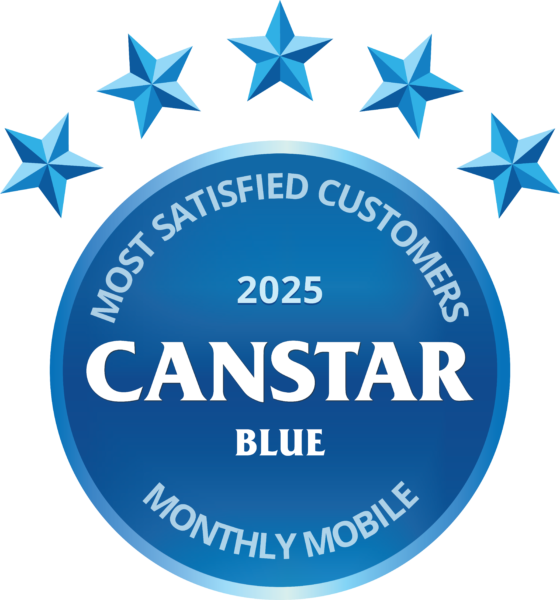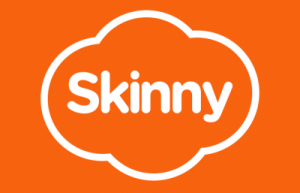Compare Monthly Mobile Plan Providers in New Zealand at Canstar Blue. Skinny, 2degrees, Spark and One NZ were compared on Overall Satisfaction, Accessibility of the Provider, Assistance Managing Data, Billing, Customer Service, Network Coverage and Value for Money.
See our Ratings Methodology.

Skinny is rated No.1 by Kiwi phone users as the country’s best monthly mobile provider.

Our review compares mobile providers on customer satisfaction, so you can discover what other Kiwis think about our compared plan providers before you sign on with one of them. Think of it like asking hundreds of your closest family, friends and colleagues which mobile plan provider they think is best!
Canstar Blue surveyed 2455 Kiwis who have a monthly payment plan with a mobile provider and asked for their feedback on their provider.
Respondents rate their satisfaction with their providers from zero to ten, where zero is extremely dissatisfied and ten is extremely satisfied. Brand satisfaction was rated by respondents on the following criteria:
The winning brand is the one that receives the highest Overall Satisfaction rating once all the scores from the Overall Satisfaction criteria are combined and averaged.
Brands must have received at least 30 responses to be included, so not all brands available in the market have been compared in this survey. The brands rated in this survey are listed below in order of best overall satisfaction.
Find more information on our Most Satisfied Customer methodology.


Skinny wins our Monthly Mobile Award on the back of a perfect set of 5-Star ratings from its customers across all our award categories.
It’s a superb result that sits alongside Skinny’s decade-long dominance of our Prepaid Mobile Award.
Skinny Mobile is a division of Spark. However, instead of offering all the extras that Spark bundles with its plans, like free and half-price Spotify, Skinny concentrates on the basics – calls, texts and data – at a reduced price. Skinny offers the following four-weekly plans:

2degrees places second on our awards table with a great set of consumer ratings. It achieves 5 Stars for Accessibility of Provider and Network Coverage, and 4-Star ratings across all other categories.
2degrees offers four monthly plans. Plans come with a great perk: a free hour of data each day to use at a time that suits your data needs. Three of the plans also allow you to add up to five extra people at discounted rates to form a group plan:
All plans offer unlimited calls to other 2degrees mobiles, hotspotting, free voicemail and are 5G ready.

Spark sits third on our table with a great 4-Star rating for Overall Satisfaction, plus three top 5-Star ratings, for Customer Service, Network Coverage and Accessibility of Provider. It earns its lowest rating, 3 Stars, for Value for Money.
Spark offers five endless data plans:
Endless data plans:
All Spark plans offer hotspotting and free voicemail.

One NZ rounds out our table earning mostly 3-Star ratings, which while not a top score is by no means a measure of dissatisfaction. Rather, One NZ’s 3-Star ratings reveal that its customers are happy with the levels of value and customer service they receive.
One NZ keeps it simple, with four mobile plans, two of which are eligible to be teamed up with companion plans for a considerable discount:
All One NZ plans offer hotspotting, fee voicemail, One NZ rewards and are 5G ready. They also offer One NZ’s satellite text facility.
NB: All prices correct as of 26/06/2025 and don’t include any current deals. For further details, visit individual providers’ websites.
It’s always interesting comparing consumers across Canstar’s research. And our latest mobile awards have revealed an interesting distinction between prepaid and monthly mobile users.
Half of the respondents in our award survey who have monthly plans have unlimited data, compared to just 18% on prepaid plans. Although around the same percentage of respondent say they use apps to communicate, rather than traditional talk and texts: 69% of monthly users vs 65% of prepaid users.
However, across both sets of mobile users, Value for Money is the major concern when rating their choice of provider, followed by Customer Service.
Here’s the full rundown of what the consumers in our survey say are the main things they consider when rating their monthly mobile providers:

There are three main mobile networks in the country, which were built by 2degrees, Spark and One NZ (formerly Vodafone). Although both 2degrees and Spark have sold their tower assets, they still use the networks they built.
In major centres, there’s very little difference between the three networks. However, in rural and remote areas coverage can vary dramatically. And then there’s 5G, which is more limited in its reach, even in major centres.
Here’s a rundown of the networks and which other mobile phone providers use them:
Network reaches 97.5% of New Zealanders (with 4G at around 97%). Spark’s network coverage map can be found here.
Network covers over 98.5% of the population (with 4G at over 96%). One NZ’s network coverage map can be found here.
Network covers 98.5% of the places New Zealanders live and work (with 4G at over 96%). 2degrees’ network coverage map can be found here.
Prepaid plans are phone plans that require you to prepay for the telco service: i.e. you pay in advance for phone services to use within a set time period. Once that expiry period is over, you need to recharge your plan in order to continue your service. If you use up some of your data/text/talk allocations before the expiry period, you will need to either recharge your plan, wait until your next recharge (and not have certain services until then) or purchase an add-on for an additional cost, such as extra data, if applicable.
Postpaid plans differ in that you pay after using your phone plan allocations. Typically, you receive a monthly bill from your telco that you have to pay by a set date. If you have used more than your plan’s inclusions, you can incur additional charges on your bill.
Over recent years the line between prepaid and postpaid mobile plans has blurred. Endless calls, texts and data and automatic monthly billing cycles are available across prepaid and postpaid, and some postpaid plans require payment midway through the billing period, making them, to some extent, prepaid.
The main difference is that if you’re not on a plan that offers unlimited calls, texts or data, a postpaid plan won’t leave you unable to make a call, send a text message, or use mobile data to chat online.
For if a prepaid plan expires, you need to spend extra money immediately to get your service back up and running. However, postpaid plans allow you to keep using your service, and simply settle the bill later.
This means that if you’re on a budget, prepaid may be the best option for keeping tabs on your spending. But when it comes to ease of use and maximum bang for your buck, it’s hard to look past postpaid plans.
 Bruce Pitchers is Canstar NZ’s Content Manager. An experienced finance reporter, he has three decades’ experience as a journalist and has worked for major media companies in Australia, the UK and NZ, including ACP, Are Media, Bauer Media Group, Fairfax, Pacific Magazines, News Corp and TVNZ. As a freelancer, he has worked for The Australian Financial Review, the NZ Financial Markets Authority and major banks and investment companies on both sides of the Tasman.
Bruce Pitchers is Canstar NZ’s Content Manager. An experienced finance reporter, he has three decades’ experience as a journalist and has worked for major media companies in Australia, the UK and NZ, including ACP, Are Media, Bauer Media Group, Fairfax, Pacific Magazines, News Corp and TVNZ. As a freelancer, he has worked for The Australian Financial Review, the NZ Financial Markets Authority and major banks and investment companies on both sides of the Tasman.
In his role at Canstar, he has been a regular commentator in the NZ media, including on the Driven, Stuff and One Roof websites, the NZ Herald, Radio NZ, and Newstalk ZB.
Away from Canstar, Bruce creates puzzles for magazines and newspapers, including Woman’s Day and New Idea. He is also the co-author of the murder-mystery book 5 Minute Murder.
Use apps to communicate with others, rather than traditional calls and texts: 69%
Use phone to arrange everyday finances: 62%
Access internet mainly through phone: 55%
Have unlimited data: 50%
Regularly use a card loaded onto phone to make contactless payments: 26%
Data cap is the major consideration when choosing phone plan: 20%
Have switched mobile providers to get better value for money: 17%
Canstar Blue surveyed 5037 New Zealand consumers across a range of categories to measure and track customer satisfaction, via ISO 26362 accredited research panels managed by Qualtrics. The outcomes reported are the results from respondents who have a monthly mobile plan. In this case, 2456 New Zealanders. Brands must have received at least 30 responses to be included. Results are comparative and it should be noted that brands receiving three stars have still achieved a satisfaction measure of at least six out of 10. Not all brands available in the market have been compared in this survey. The ratings table is first sorted by star ratings and then by mean overall satisfaction. A rated brand may receive a ‘N/A’ (Not Applicable) rating if it does not receive the minimum number of responses for that criterion.
The past winners from Canstar Blue’s Monthly Mobile Plan ratings:

Best-rated Monthly Mobile Plans - December 2nd
If you’re on the hunt for a cheap broadband internet plan, what should you look out for? Compare providers with Canstar Blue.
– Read more
Best-rated Monthly Mobile Plans - December 2nd
Competition in the wireless broadband market is fierce. The big broadband providers like wireless broadband technology because they don’t have to pay to deliver their services over the fibre networks, which belong to other companies. …
– Read more
Best-rated Monthly Mobile Plans - December 2nd
If each person in your household has a separate endless data mobile plan, you could all be overpaying. By bundling the plans together on a group endless data plan under one provider, you could make …
– Read more
Best-rated Monthly Mobile Plans - December 1st
Below we cover the best deals from mobile phone providers across prepaid and monthly plans. The offers we think deliver the best value are our Deals of the Month!
Deal of the Month: Kogan
This month Kogan …

Best-rated Fibre Broadband Providers - December 1st
Below we cover the best deals from broadband providers across fibre and wireless plans. The award we think delivers the best value is our Deal of the Month!
Deal of the Month: Mercury
Mercury is offering six …